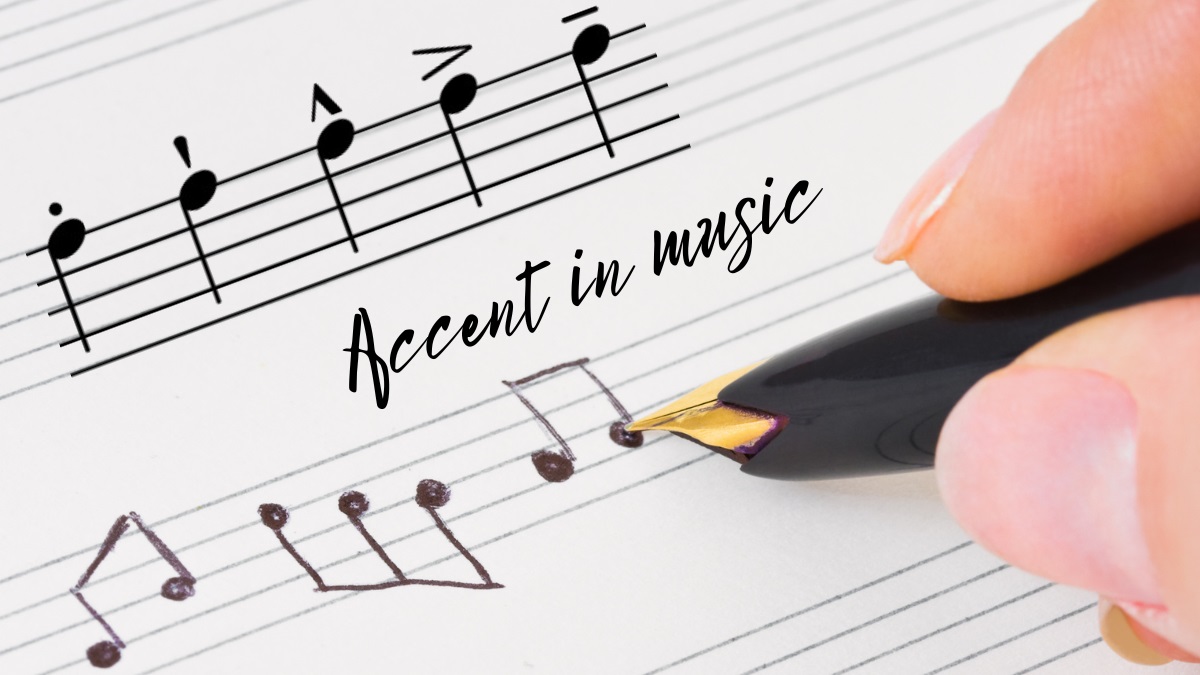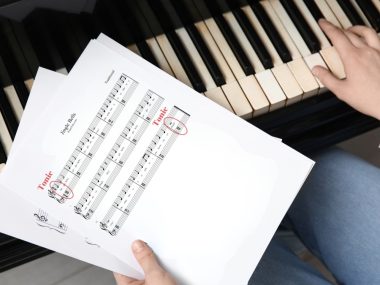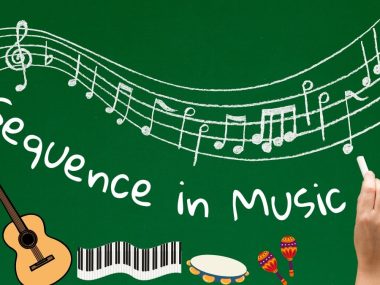Have you ever heard of the phrase, “music is the language of the soul?” Well, there’s actually more truth in that than you might think!
It’s said time and time again that music is a universal language. And like any spoken language, there are certain types of structural elements that can transform a mere collection of notes into a grand composition. These elements are called “accents.”
If you’re unfamiliar with music accents, you’ve come to the right place. This is your one-stop guide to musical accent, where you’ll find answers to questions like, “what is an accent in music?” and “what are the types of accent marks in music notation?”
Let’s dive right in!
What Is an Accent in Music?

Accent in music pertains to the emphasis or prominence in which a note should be played, usually in the form of increased volumes. Where written language uses italics, bold, and underline, accents in music use staccato, staccatissimo, marcato, accent, and tenuto.
What Is the Purpose of Accent In Music?
Musical accents make a regular piece stand out through a combination of vibratos, legatos, trills, bends, and various other types of music embellishments. They give a musical composition a unique voice that commands the listener’s attention.
When used properly, accents can instantly turn a piece into a highly attractive musical composition that sticks out from the rest.
Accent marks often appear directly above or below a note to indicate that a note should be played differently from the rest, giving it a particular phonetic value. They can be placed on just about any note, from whole notes and beyond.
What Are the Categories of Accents in Music?
Accents in music are often divided into three main categories: dynamic, agogic, and tonic. Let’s take a look at the differences between them:
Dynamic Accent
A dynamic accent, also referred to as stress accent, is the most common type of accent and can be seen in almost every musical composition.
It indicates that a particular note should be played louder or stronger than the notes surrounding it, therefore creating a dynamic or attention-catching emphasis on the music.
Agogic Accent

An agogic accent indicates that a particular note should be played longer or shorter than the notes surrounding it. It can also indicate a pause of silence.
It’s grouped into four categories, as follows:
- Note expressed in a longer notated duration
- Note expressed in an extended duration within its full-time value without changing the tempo
- Note expressed in an extended duration in order to temporarily decrease the tempo of the music
- Note expressed in a delayed onset, like pausing before playing another note.
Mostly, this accent is used to add emotion and expression to a certain lyric.
For instance, instead of continuously playing a dull sound at a measure of 4/4 time with 4 quarter notes beats or its equivalent, the musician would add an agogic accent on the fourth beat to make the note stand out. The effect produced can be any of the mentioned above.
Tonic Accent
A tonic accent, also referred to as pitch accent, is the least used of the three accents. It’s added to a composition to indicate that a certain note should be higher in pitch as opposed to higher in volume. For this reason, it’s used for inflection or flowering purposes.
Musical Accents According to Lerdhal and Jackendoff

Fred Lerdahl was an American composer and music theorist. Ray Jackendoff was an American linguist. Together, they published a book in 1983 called the Generative Theory of Tonal Music, or GTTM for short.
The GTTM aims to unite our capacity for musical understanding through the rationalization of structural compositions. Throughout the years, the GTTM has spurred multiple research in the fields of music theory, cognitive musicology, and music cognition.
In the book, Lerdhal and Jackendoff discussed the following accents:
Phenomenal Accent
A phenomenal accent gives emphasis to a particular moment in a musical flow.
According to Lerdahl and Jackendoff, these moments refer to the music points of “local intensification.” These points are caused by a composition’s change in intensity alongside simultaneous note loudness, density, duration, and pitch.
Structural Accent
A structural accent refers to the harmonic and melodic shift of gravity in a musical section or the start of a musical phrase. Cadence is a great example of a structural accent.
Metrical Accent
As the name suggests, a metrical accent refers to any beat that has a strong metrical context.
Musical compositions are often filled with musical divisions and a set number of beats, with some carrying more emphasis than others.
Accents that naturally occur are called metrical accent, or simply metric accent. Most Western music has accented first and third metrics.
In Essen and Povel’s 1985 research study Perception of Temporal Patterns, the three rules that govern metrical accent detection are as follows:
- Accents are perceived as isolated events
- In sequences of three or more events, the first and last events are accented
- When a pair of events are isolated, the second event is accented but only if it’s relative to the first event
What Do Accent Marks in Music Notation Mean?
There are five types of accents in music, all of which have different methods of accentuation. This includes staccato, marcato, staccatissimo, tenuto, and a wedge-shaped accent mark simply referred to as accent.
Staccato •
A staccato note is indicated by a simple period above or below a note. As you might have expected, this accent note tells the player to pause or shorten the note, usually by half of its written value, before moving on to the subsequent note.
Similar to the periods used in written language, a staccato creates a separation between two notes.
Staccato comes in three common varieties, as follows:
- Mezzo staccato: slightly detached and accented; a combination of staccato and tenuto
- Staccato forzato: short but strong; a combination of staccato and marcato
- Staccato duro: hard and distorted, but only for a short duration; a combination of staccato and martellato
Marcato ∧

Marcato, or simply marc, is a combination of accent and staccato. This wedge-shaped vertical accent indicates that a note should be played louder than the rest of the corresponding notes.
A marcato mark, also known as martellato (Italian for ‘hammered’) is about as loud as an accent mark and about as short as a staccato mark.
In his book Evoking Sound, James Mark Jordan brilliantly describes the marcato sound as a “rhythmic thrust followed by a decay of the sound.”
By classically trained musicians, the marcato mark is dubbed as the “false version” of marcato. In jazz articulation, marcato is stated as “daht”.
Accent >
An accent mark, indicated by a wedge-shaped horizontal accent mark or a greater-than symbol, emphasizes a note without lengthening the note’s written value.
The emphasis usually starts at the beginning of the note or at the third beat of a measure before quickly narrowing down.
Compared to the “false version” of marcato, the accent is the “true version” of marcato.
Pieces with heavy syncopation, like Giovanni da Firenze’s madrigal Appress’ un Fiume and the refrain from Agincourt Carol’s Deo Gratias, have accent marks that fall on every other quarter note, eighth note, sixteenth note, and so on.
In jazz articulation, this musical accent is simply referred to as “dah”.
Staccatissimo ▽
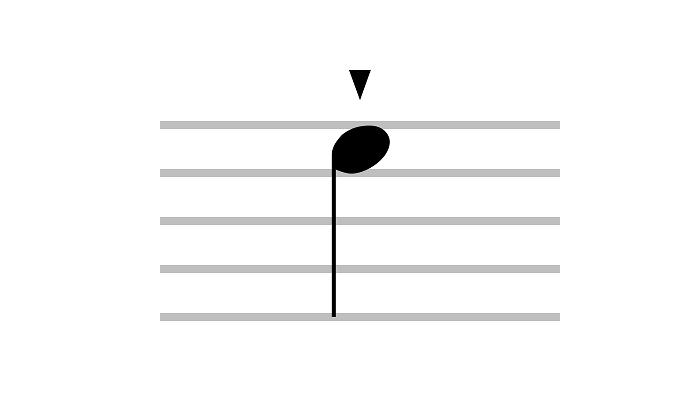
A staccatissimo mark is used few and far in between, primarily because composers usually opt for staccato. It’s quite similar to a staccato mark, except the note in question is cut short faster than a staccato accent.
Due to this, composers up to the time of Mozart used staccato and staccatissimo interchangeably.
In traditional music, a quarter note or staccatissimo crochet is played as a lightly articulated sixteenth note or semi-quaver, where the rests then follow the remainder of the beat.
Tenuto —
A tenuto mark is the complete opposite of the staccato mark. Where staccato tells players to pause or shorten a note, the tenuto mark indicates that a note should be played in its full value before moving on to the next.
If a musical piece has several tenutos in a row and is accompanied by a slur, an accent called “tenuto vari” is achieved. Tenuto vari is detached but empatic.
Other Commonly Used Musical Notations In Music
Apart from the accents mentioned above, you’ll likely encounter the following accents:
Slash
A slash notation represents repeated notes that require a player to improvise their own rhythm pattern according to the symbol given by the staff.
Usually, this is drawn in three different manners:
- One slash: for the whole duration of the given note value, eight notes are repeated
- Two slashes: for the whole duration of the given note value, sixteenth notes are repeated
- Three slashes: unmarked tremolo, repeated as many times as possible throughout the whole note duration
Dotted Note

A dotted note increases the overall duration of the note by approximately half its original value, similar to what’s shown with the staccato accent.
For instance, a dotted half note equates to a half note of a quarter note. A note with two, three, or four dots lengthens a musical duration by a quarter, an eighth, and a sixteenth respectively.
The use of double- and triple-dotted notes appear in Frédéric Chopin’s Prelude in G major for piano, Op. 28, No. 3.
Keep in mind that, although theoretically possible, notes with more than three dots are extremely rare. Therefore, it’s unlikely that you’ll encounter them unless you’re playing with pieces with heavy syncopation.
Beamed Tremolo
Notes with a beamed tremolo require the player to rapidly alternate between two different notes.
Similar to dotted notes, beamed tremolos are beamed with either one, two, or three layers. The rules for this particular accent are fairly similar to the slash accent, where one beam equates to one stash, two equates to two slashes, and so on.
Slur
Also known as the swoopy line, the slur requires players to play the note in a smooth manner. The notes should be played with an articulation called legato, meaning to play without separation.
If the stem is pointing downward, the slur is generally placed over the notes. If the stems are pointing upwards, the slur is placed underneath.
Tie
A tie in music notation connects the heads of two subsequent notes with the same pitch, which therefore indicates that both of the notes should be played as one.
Although it shares a similar appearance to a slur, keep in mind that slurs join notes of two or more dissimilar pitches to be played seamlessly, but independently.
Portato
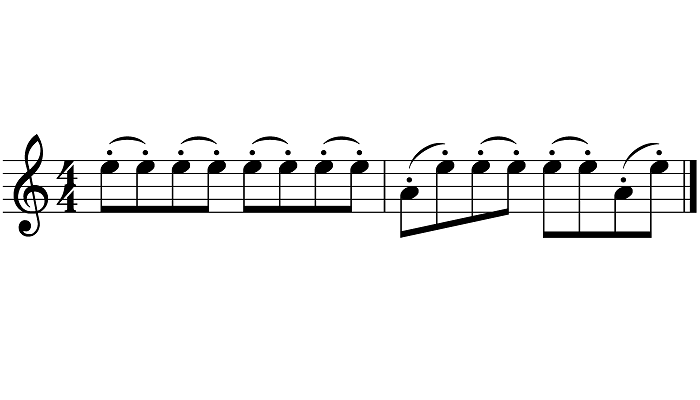
A portato accent is a combination of half-slur and half-staccato, making it both smooth and choppy. The notes are played in a more defined and smooth manner than either of the mentioned two accents.
Sforzando
A sforzando accent, also known as sforzando, sforzato, forzando, or forzato, is commonly abbreviated by sf, sfz, or fz symbols. It indicates a loud, forceful accent without about the same expression depending on the musical notation’s dynamic level.
Fermata
A fermata, also known as hold, pause, cyclops eye, or birdseye, indicates that a note should be sustained and prolonged beyond the normal note value duration.
There’s no metric as to how long the note should be held; it’s entirely up to the discretion of the conductor or performer. Usually, it’s twice as long. However, it isn’t unheard of to sustain a note triple or quadruple the note’s original value.
If performed in a concerto, the fermata symbol indicates a cadenza or an improvised ornamental passage.
Fortepiano

Fortepiano follows a loud-quiet pattern, where the player plays a note loudly (forte) then immediately softly (piano).
As you may have guessed, the word fortepiano in Italian etymology is translated as ‘loudsoft.’
This musical dynamic is usually abbreviated with the letters fp. It’s quite common for a fortepiano accent to be followed by a crescendo, AKA a gradual increase in tone intonation and dynamics.
One of the most common musical pieces that begin with a fortepiano is Beethoven’s Piano Sonata No. 8.
